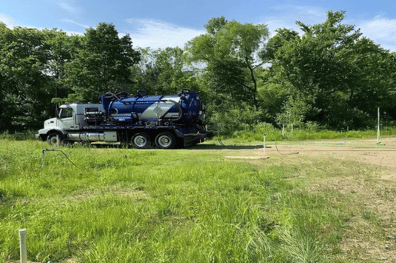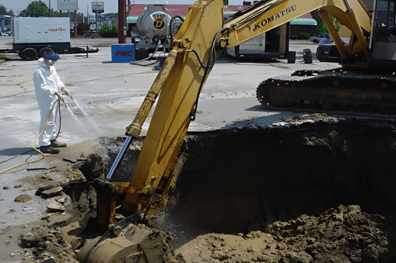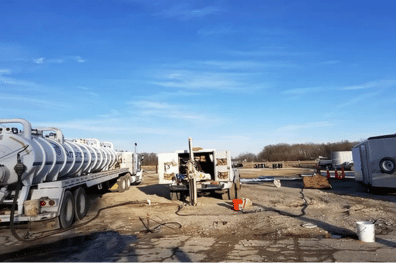ORIN successfully reduced the amount of LNAPL within the groundwater utilizing a combination of in situ chemical oxidation and vacuum extraction. Approximately four vacuum extraction events took place prior to the full scale injection event. A vacuum extraction truck was onsite and was utilized simultaneously to the injection event. 122 injection wells with a screened interval of 15 to 35 ft bgs were used to deliver the treatment chemistry. A total of approximately 86,430 gallons of treatment chemistry was injected across the site.
The Challenge
The site faced significant contamination challenges:
- LNAPL contamination reaching depths of 18.5 feet
- Complicated geology consisting of silty and sandy clay
- Contamination varying from 12 to 32 feet below ground surface
- Substantial free product presence in groundwater
The Solution: Dual Treatment Approach
The remediation team implemented a sophisticated treatment strategy combining two powerful methods:
- Vacuum Extraction:
- Conducted four separate extraction events
- Utilized vacuum extraction truck during injection
- Provided immediate removal of free product
- In-Situ Chemical Oxidation:
- Deployed 122 injection wells
- Wells screened from 15 to 35 feet below ground
- Utilized sodium persulfate activated with caustic
- Injected 86,430 gallons of treatment chemistry
Impressive Results
The project achieved significant contamination reduction after just one treatment round:
- Free Product Reduction:
- 83% reduction across all injection wells
- 67% reduction in monitoring wells within the injection area
- 18% reduction in benzene concentrations
Key Success Factors
Several elements contributed to the project’s success:
- Strategic combination of treatment technologies
- Extensive well network for optimal distribution
- Precise timing of vacuum extraction with chemical injection
- Carefully selected chemical oxidation compounds
Moving Forward
The site continues to be monitored to:
- Track long-term treatment effectiveness
- Determine if additional treatment is needed
- Document the sustained reduction in contamination levels
This project demonstrates the effectiveness of combining traditional vacuum extraction with innovative chemical oxidation techniques for challenging petroleum contamination scenarios.



